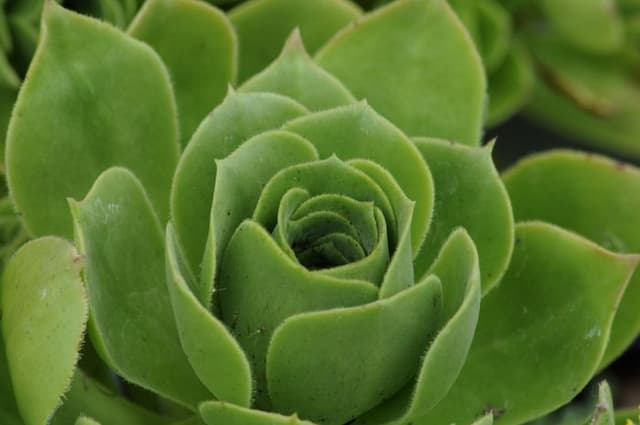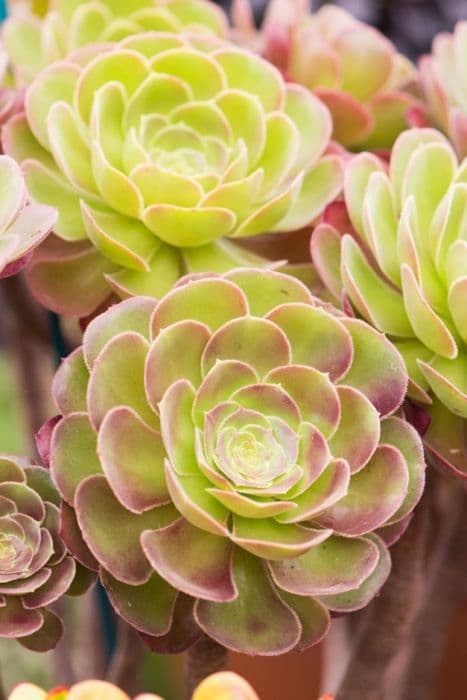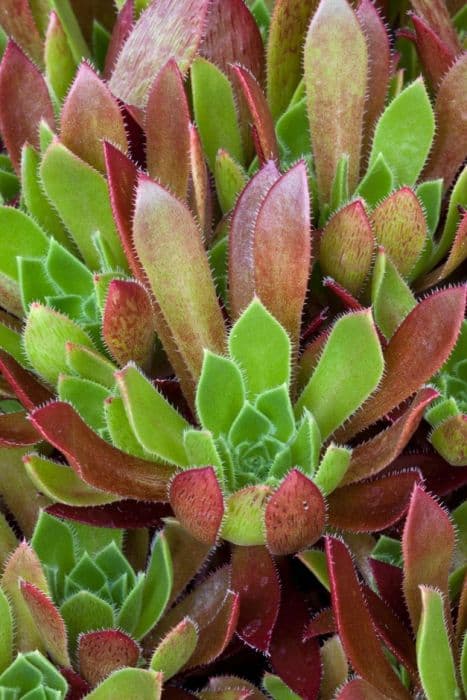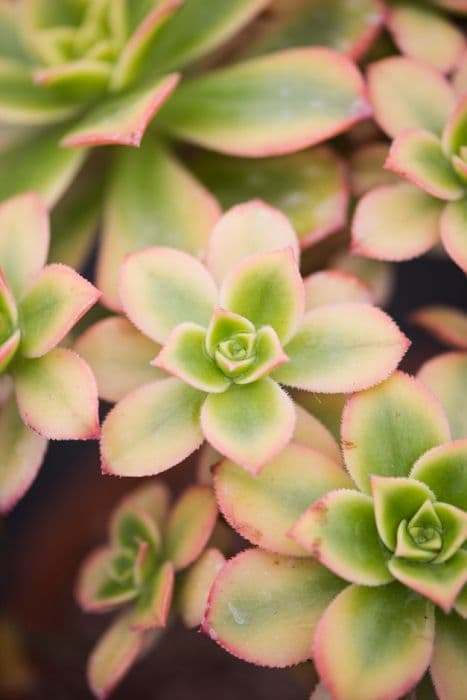Hen and Chicks Sempervivum 'Bronco'

ABOUT
The Sempervivum 'Bronco', commonly known as Hen and Chicks, exhibits an attractive rosette formation, a pattern that's particularly symmetrical and geometric. Each rosette consists of thick, fleshy leaves that are adept at storing water. These leaves are generally tight and pointed, spiraling into a central point. The 'Bronco' variety is recognized by the coloration of its leaves; they often possess a deep hue, typically a rich green that can appear to be almost bronze or purple especially towards the tips, giving the plant a striking and vibrant appearance. Over time, the rosettes can produce offsets on stolon-like structures, which surround the parent rosette much like chicks around a hen, which is how they come by the common name. Moreover, the leaves may have a slightly rubbery or waxy texture, which enhances their drought resistance. The appearance of Sempervivum 'Bronco' can vary with the seasons, often intensifying in color during the colder months, while sometimes being more muted during the growth season.
About this plant
 Names
NamesFamily
Crassulaceae
Synonyms
Hen And Chicks, Houseleek
Common names
Sempervivum 'Bronco'.
 Toxicity
ToxicityTo humans
Hens and Chicks, the common name for Sempervivum 'Bronco', is generally considered non-toxic to humans. Ingestion of this plant typically does not lead to poisoning or serious health consequences.
To pets
Hens and Chicks, also known as Sempervivum 'Bronco' to gardeners, is not toxic to pets. Cats and dogs that may ingest this plant are unlikely to experience poisoning or adverse health effects as a result of their interaction with it.
 Characteristics
CharacteristicsLife cycle
Perennials
Foliage type
Evergreen
Color of leaves
Mixed
Flower color
Pink
Height
6 inches (15 cm)
Spread
12 inches (30 cm)
Plant type
Succulent
Hardiness zones
5
Native area
Europe
Benefits
 General Benefits
General Benefits- Easy to Care For: Sempervivum 'Bronco', commonly known as Hens and Chicks, is very low-maintenance and can thrive with minimal attention, making it ideal for beginners or those with busy schedules.
- Drought Tolerant: This succulent is highly drought-resistant, requiring little water once established, which is great for water-wise gardens or regions with little rainfall.
- Cold Hardy: Hens and Chicks are resilient to cold temperatures and can survive in below-freezing conditions, making them suitable for a variety of climates.
- Attractive Foliage: The plant offers unique and appealing foliage with a bronzy hue, adding visual interest to garden spaces and containers.
- Propagation: It produces offsets easily, which allows for simple propagation and the ability to expand your collection or share with friends.
- Pest Resistant: Sempervivum 'Bronco' is naturally resistant to most pests, reducing the need for chemical treatments in the garden.
- Versatile: It can be grown in rock gardens, containers, ground covers, and even on green roofs, offering great versatility in landscaping options.
- Year-Round Interest: With evergreen leaves, Hens and Chicks provide aesthetic appeal throughout all seasons.
 Medical Properties
Medical PropertiesThis plant is not used for medical purposes
 Air-purifying Qualities
Air-purifying QualitiesThis plant is not specifically known for air purifying qualities.
 Other Uses
Other Uses- Roof planting: Sempervivum 'Bronco', commonly known as Hen and Chicks, can be used in green roofing projects because they are resilient and can thrive in the harsh conditions on rooftops.
- Craft projects: Their rosette shapes and variety of colors make Hen and Chicks a popular choice for creating living wreaths or decorative moss art.
- Ground cover: Hen and Chicks can be used to cover bare patches in gardens, as they form dense mats that can stifle weeds and mitigate erosion.
- Garden borders: They work well as low-maintenance, drought-tolerant options for defining the edges of garden beds and walkways.
- Fairy gardens: Due to their small size and interesting shapes, Hen and Chicks are perfect for creating whimsical fairy gardens and miniature landscapes.
- Container gardens: Hen and Chicks are ideal for container gardening, making it easy to move and rearrange for different visual effects or to bring them indoors in extreme weather.
- Water-saving landscapes: In xeriscaping, they are used to conserve water while providing greenery and visual interest in the garden.
- Living mulch: Their spreading nature allows Hen and Chicks to act as a living mulch, helping soil retain moisture and reducing the need for traditional mulching materials.
- Rock gardens: They are a classic choice for rock gardens due to their ability to grow in rocky, well-drained soil conditions and complement the stones with their foliage.
- Education: Hen and Chicks are often used in schools or educational programs to teach children about plant propagation, as their offsets are easy to observe and grow.
Interesting Facts
 Feng Shui
Feng ShuiThe Hen and Chicks is not used in Feng Shui practice.
 Zodiac Sign Compitability
Zodiac Sign CompitabilityThe Hen and Chicks is not used in astrology practice.
 Plant Symbolism
Plant Symbolism- Perseverance and Tenacity: Also known as Hen and Chicks, Sempervivum 'Bronco' is well-regarded for its ability to thrive in poor soils and harsh conditions, symbolizing the resilience and the ability to endure challenging situations.
- Protection: The rosettes of the Hen and Chicks plant have been traditionally used to protect roofs and homes when planted atop, representing a shield against lightning and fire.
- Enduring Love: Given its characteristic of retaining water and thriving in arid conditions, the Hen and Chicks plant can symbolize an enduring and self-reliant love that lasts through hard times.
- Renewal and Rebirth: Hen and Chicks propagates by producing offsets, representing the idea of new beginnings and continual renewal.
 Water
WaterHen and chicks prefer moderate watering with good drainage to prevent root rot. Water the plant thoroughly, allowing the soil to dry out before watering again. In spring and summer, water once a week with approximately 8 ounces per plant, depending on the pot size and environmental conditions. During the dormant period in winter, reduce watering to once every 2-3 weeks, providing slightly less water.
 Light
LightHen and chicks thrive in full sun to part shade but do best with several hours of direct sunlight. Ideal planting spots are south or west-facing locations that receive at least 6 hours of sunlight daily. They can tolerate light shade but may not grow as compactly or produce vibrant colors.
 Temperature
TemperatureHen and chicks are hardy succulents that can tolerate a wide temperature range. They thrive best between 65°F and 75°F, but can survive temperatures as low as 20°F and as high as 90°F. It's important to protect these plants from extreme cold and frost to prevent damage.
 Pruning
PruningPruning hen and chicks is usually not necessary as they naturally maintain their rosette shape. However, it is beneficial to remove dead leaves or spent flower stalks to encourage healthier growth. This can be done as needed, any time of the year when you notice dead or dying plant elements.
 Cleaning
CleaningAs needed
 Soil
SoilHen and chicks prefer well-draining soil with a mix of sand, peat, perlite, or pumice to provide aeration. Aim for a soil pH between 6.0 and 7.5 for optimal growth.
 Repotting
RepottingHen and chicks typically need to be repotted every two to three years to refresh the soil and provide room for growth.
 Humidity & Misting
Humidity & MistingHen and chicks thrive in dry conditions and do not require high humidity levels. Average room humidity is generally sufficient for these succulents.
 Suitable locations
Suitable locationsIndoor
Place in bright light, water sparingly, ensure pot has drainage.
Outdoor
Plant in sunny spot with good drainage; water infrequently.
Hardiness zone
3-9 USDA
 Life cycle
Life cycleThe life of the Hen and Chicks plant ('Bronco' variety) begins with seed germination, which typically occurs in spring or summer under optimal warmth and moisture conditions. The seedlings develop into rosettes, the plant's primary form, featuring tightly packed, fleshy leaves that can withstand drought due to their water-storing capabilities. As the rosettes mature, they produce offsets, commonly referred to as "chicks," which grow around the base of the "mother" hen through a process called vegetative propagation. These chicks eventually take root and become independent plants, contributing to the spread of the colony. After several years, the mother hen may flower, producing a tall bloom stalk with star-shaped flowers, usually initiating the end of her life cycle. After flowering, the hen typically dies back, leaving the chicks to continue the colony's growth and continuation.
 Propogation
PropogationPropogation time
Spring-Early Summer
Sempervivum 'Bronco', commonly known as Hen and Chicks, is most commonly propagated through offsets. These are small plants that develop at the base of the parent Hen and Chicks and are connected by a short stolon, or stem. To propagate, gently remove the offsets from the mother plant during the growing season, which is typically spring or early summer. Allow the offset to dry for a day or two to form a callus on the cut surface; this helps to prevent rot when planted. Plant the offset in well-draining soil, and water it sparingly until roots develop and the new plant becomes established. This method leverages the natural reproductive strategy of Hen and Chicks and is an efficient way to produce new plants that are genetically identical to the parent.









